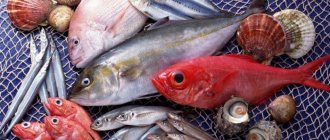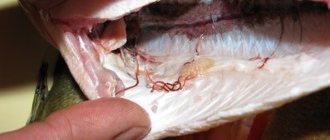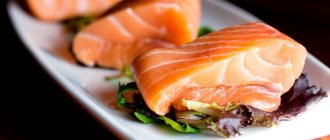Poisoning from fish, red or black caviar, and seafood is a fairly common occurrence. In this regard, even fresh and properly prepared fish dishes can become dangerous. Often fish provokes infection with botulism and other severe toxic infections. Often, problems can be caused by many people’s favorite rolls and sushi, which contain raw fish.
The most common causes of intoxication:
- Bacterial toxins. Problems may arise due to improper transportation or storage. For example, bacteria multiply intensively in defrosted raw materials that remain warm for a long time. This is typical for both fresh and canned fish.
- Fish may initially be infected with bacteria and parasites. Toxins and harmful microorganisms accumulate in fish living in polluted waters.
- Incorrect preparation of fish. Thus, under-salting or insufficient heat treatment during smoking can provoke the growth of pathogenic microorganisms in fish and cause the development of acute intoxications.
- Chemical toxins. Harmful substances enter fresh and salt water and accumulate in the food chain. Organochlorine compounds, pesticides, and methylmercury can accumulate in fish and seafood.
Many inhabitants of the deep sea, in particular mollusks that live in insufficiently clean waters, are often carriers of pathogenic viruses. For example, hepatitis A virus or norovirus.
The most common cause of poisoning is the consumption of fish infected with Salmonella bacteria. Thus, researchers Suleidzhan and Keldikulova believe that “neglect of the requirements of food hygiene when salting fish often led to its infection mainly with Gertner bacteria, as well as food products prepared from fish” (Suleidzhan B.Zh. and Keldikulova U.K., 2011, p. 70).
Reasons for the development of poisoning
Fish poisoning can be caused by bacteria and toxins that have developed in it as a result of improper storage and preparation. Fresh, only caught fish can be infected with parasites and worms.
The following are the main reasons why fish poisoning may develop:
- Eating fresh fish. Recently, it has become fashionable to eat rolls and sushi that contain raw red fish.
- Cooking dishes from stale, rotten fish. Failure to follow the rules when freezing fish. Fish should only be frozen once.
- Repeated freezing leads to the proliferation of pathogenic dangerous bacteria in it. Please note that as soon as the fish is defrosted, you must immediately begin heat treatment. Colonies of bacteria grow on it within half an hour.
- Improper storage or preparation of smoked and salted herring and mackerel. For example, when smoking, many unscrupulous manufacturers use solutions that imitate the smell of smoke and sell raw, unsuitable herring, gobies or other fish.
- Eating poisonous fish, such as fugu.
You should not think that poisoning is only possible with fresh fish; this is a mistaken opinion. You can even get poisoned from boiled or fried fish products.
The most perishable product
Any protein food spoils easily and quickly without freezing, especially fish. When not frozen, rapid processes of rotting, proliferation of pathogenic bacteria and accumulation of toxins quickly begin in it.
At first, it is easy to hide the specific signs and smell with various tricks - salting, smoking or drying for sale in stores or markets. Public catering outlets resort to other tricks - spoiled fish is boiled or fried and served, combined with sharp-smelling ingredients and spices.
Therefore, fish is one of the most dangerous foods - it can easily be poisoned in any form. However, it does not have to decompose or smell bad. For bacteria to multiply, very minor violations of the storage regime are sufficient.
Several signs of a spoiled product
How to distinguish spoiled fish from fresh? Not necessarily by smell, although it is specific, ammonia. After all, it’s quite rare that frankly spoiled goods are sold in stores and on the market.
Fresh fish.
Here are a few signs that fresh fish should not be when buying:
- never buy a carcass with a frozen layer of ice. Most likely, it was defrosted several times, and this is the main condition for improper storage;
- fresh meat is elastic and does not fall apart. When pressed, no obvious dents are formed on the surface, and the ribs do not protrude through the abdomen;
- red fish poisoning occurs after eating products that are dull, gray in color;
- fresh - should not be dull, covered with sticky mucus, with cloudy eyes and a swollen or soft abdomen. She does not have gray, brown or greenish gills or unevenly shed scales;
- for dried meat, the carcass is dense, dry, the fat is transparent, and has a pleasant amber color. The fibers on the cut are not brown, but reddish. Poisoning from dried fish can occur if it is stored incorrectly and for a very long time.
- for salted meat, the carcass should be shiny and elastic, without a specific odor. A “tired” fish can be identified by strongly pulling the lower pelvic fins: they are easily separated along with a piece of the abdomen. In smoked meat, the fibers easily separate from the bones, as if it had been boiled.
Any high-quality fish has fairly dense skin; it should not peel off in pieces. In herring and mackerel, after long storage, the subcutaneous fat on the back turns yellow.
Main clinical manifestations of poisoning
Symptoms of fish poisoning develop during the first 24 hours. The speed of their development depends on the amount of toxins and putrefactive bacteria that were in the eaten dish.
Below are the main signs of poisoning from fish that have been spoiled:
- Nausea and vomiting of food eaten. Vomiting brings temporary relief.
- Cramps and pain in the abdomen. At first, the pain may be localized in the stomach, and then spread to the entire abdomen.
- Diarrhea. The stool becomes liquid and unformed.
- Belching, which may have a fishy odor.
- Flatulence.
- Intoxication syndrome, which is manifested by fever, general weakness, and body aches.
In case of poisoning by poisonous fish, symptoms may begin to appear immediately, within a few minutes or hours after eating. The following symptoms may develop:
- Loss of sensitivity in the arms and legs, numbness of the lips, tongue, and facial skin. Such symptoms are characteristic of neurotoxic poison.
- Blurred consciousness.
- Copious watery diarrhea.
- Taste in the mouth with a metallic tint.
- Impaired coordination and speech.
Treatment and prevention
If the diagnosis is correct, no treatment is required. The condition goes away on its own. Symptoms usually appear in less than 6 hours.
Preventative treatment:
· Good hygiene in the production of canned fish and fish dishes.
· Low storage temperature is also important to prevent the development of pseudo histamine poisoning.
Measures for individual cases or outbreaks:
· In case of several facts of poisoning - study of food products.
· Notification of sanitary services.
· If multiple cases of poisoning are suspected, it is advisable to contact a medical facility.
Why is poisoning dangerous?
Fish poisoning can lead to severe disruptions in the functioning of the entire body. It is especially dangerous for children and elderly people. In this category of patients, the body cannot fully fight the infection.
Possible negative consequences of fish poisoning include:
- Infectious-toxic shock is a serious condition caused by the effect on the body of toxins released by pathogenic bacteria. A person develops tachycardia (pulse increases), hypotension (arterial blood pressure drops), and consciousness is impaired. The patient may fall into a comatose state.
- Dehydration. This condition occurs due to excessive diarrhea and vomiting. At the same time, body temperature decreases (hypothermia), the skin becomes pale and flabby. Severe dehydration can lead to organ failure and death. In children under 3 years of age, dehydration develops especially quickly, literally within a few hours after the onset of symptoms of poisoning.
- Acute renal failure develops against the background of infectious-toxic shock. In this case, the kidneys stop performing their function.
- Respiratory arrest can occur as a result of eating poisonous fish.
- Acute gastritis can occur due to damage to the gastric mucosa by toxins. Manifested by epigastric pain, nausea, vomiting, heartburn.
- Pancreatitis (inflammation of the pancreas). This is characterized by severe girdling pain, digestive disorders, prolonged vomiting and nausea.
Types of intoxication
Poisoning from smoked fish – cold and hot smoked. Occurs due to a violation of the temperature regime and salt dose. As a result, parasitic microbes do not die, but continue to multiply. Consuming such a product can poison a child or an adult. Mackerel poisoning often occurs.
It is easy to get poisoned with dried or dried fish if the production technology is not followed - for example, the recommended temperature was not observed, the fish was stored in an unsanitary condition, or lived in contaminated river water.
Fried fish intoxication occurs when the cooking process is disrupted. To kill the parasites, you need to fry the fillets at high temperatures for a long period of time. If time is not maintained, a complex disease can be caused. More often used for cooking tuna, trout, horse mackerel and others.
Intoxication with salted or pickled fish occurs when there is a deficiency of salt in the marinade, which does not kill the pathogens.
Fish threatens with dangerous types of disease, but doctors advise not to give up consuming this product. Fish meat contains a number of useful microelements that are required for humans.
First aid for fish poisoning
The health prognosis depends on correctly provided first aid. Mild poisoning can be treated at home. Severe toxic infections, as well as poisoning by poisonous varieties of fish, can only be treated in a hospital setting.
Below is a detailed description of what to do in case of fish poisoning before the ambulance arrives:
- First of all, you need to cleanse your stomach of possible remnants of poor-quality food or bacteria. To do this, you need to drink 1 liter of water in one gulp and throw it up. This procedure should be repeated several times.
- Rinse the intestines using an enema. At home, an enema is done only with ordinary boiled water. Adding medications to an enema is prohibited. The water temperature should be room temperature. The enema is carried out until clear water is obtained. Colon lavage will help remove toxins from the body.
- After washing the stomach and intestines, you need to give the poisoned person something to drink. It is best to drink still mineral alkaline water and sweet black tea.
- The patient should take sorbents, for example, Activated carbon, Atoxil, Enterosgel, Sorbex, Smecta, White coal.
Please note that when the first symptoms of poisoning appear, you should immediately call emergency medical help. Emergency medicine doctors will be able to assess the severity of the patient’s condition and will tell whether hospitalization is necessary.
Definition
· Histamine is a biogenic compound in the form of colorless crystals, easily soluble in water and worse in alcohol.
· Biogenic amines are substances that are formed from free amino acids in foods.
· In the body, histamine is usually in a bound state and does not cause harm. In a free state, it causes muscle spasms, a decrease in pressure and dilation of capillaries.
· In medicine it is used in preparations for migraines, asthma, articular rheumatism, and urticaria.
· Histamine is formed by the amino acid histidine. Other biogenic amines, such as tyramine, tryptamine and serotonin, can cause a kind of poisoning (pseudo-allergy).
· The disease is caused by a histamine hypersensitivity reaction and produces relatively mild symptoms that can be confused with other allergic reactions and shellfish poisoning. The condition often does not require hospitalization or treatment.
Further tactics for patient management
Doctors from the ambulance team, after examining the patient and collecting anamnesis, will decide whether the poisoned patient needs to be hospitalized or not. In the case of a serious condition of the patient, severe dehydration, impaired consciousness, hospitalization in a hospital in the infectious diseases or intensive care unit is necessary. In case of poisoning by poisonous fish, treatment is carried out in a toxicology hospital.
If the patient's condition is not in danger, treatment can be carried out at home. Medications must be prescribed by a doctor. Self-medication can be dangerous to the health and life of the patient. Treatment is prescribed by an infectious disease specialist from a clinic or a local therapist.
Helpful information
Find out:
- Benzodiazepine poisoning and intoxication with benzodiazepine-like hypnotics and .
- When poisoning with beta blockers , what consequences and complications arise from it.
- The most common household and occupational sources of lead poisoning . Why is it dangerous, and what irreversible consequences can it cause in the human body?
- How common is calcium antagonist and cardiac glycoside ? How to avoid complications, and what antidotes exist.
- Limit amount of substance for ethylene glycol intoxication . Where is this complex alcohol found and why accidents are more often recorded among alcoholics and children.
- How dangerous is fluoride poisoning , and what treatment regimens exist, depending on age and the amount of the product used.










